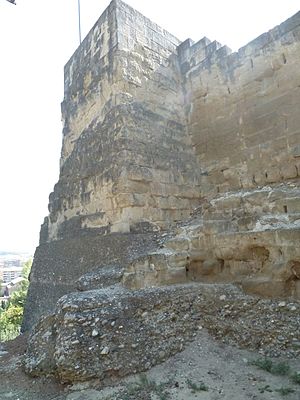Lubb ibn Muhammad facts for kids
Lubb ibn Muhammad ibn Lubb (who lived until 907 AD) was an important Muslim leader, known as a wali, which is like a governor. He was in charge of the cities of Tudela (from 890 to 907) and Larida in what is now Spain. He was a powerful lord in the northern part of Al-Andalus, the Muslim-controlled areas of the Iberian Peninsula.
Contents
Lubb's Family and Background
Lubb was part of a very important Muslim family called the Banu Qasi. His father was Muhammad ibn Lubb, and his family was known for being powerful in the region.
Lubb ibn Muhammad had three sons:
- Abdallah ibn Lubb: He was sadly killed by Lubb's own brother, Mutarrif ibn Muhammad.
- Muhammad ibn Lubb: He took control of some family lands in the years after his father.
- Furtun ibn Lubb: After his father died, he was forced to leave Larida and later became a Christian.
How Lubb Gained Power
In 889, a leader named Isma'il ibn Musa became ill. He gave his power to his sons, Mutarrif ibn Isma'il and Musa ibn Isma'il. These two went on a trip to a place called Barbitanya. During this trip, Musa was killed, and Mutarrif was captured by the governor of Huesca, Muhammad al-Tawil of Huesca.
Al-Tawil then attacked and took over Larida. To stop Al-Tawil from becoming too powerful, the Ummayyad ruler, Abdallah ibn Muhammad, decided not to give him control of Larida. Instead, he gave it to Lubb's father, who then passed control of the city to Lubb. This is how Lubb became a powerful leader in Larida.
Lubb's Time as a Leader
From his base in Larida, Lubb ibn Muhammad was often fighting against Christian nobles from Aragon and Catalan areas. These Christian groups were slowly moving south and settling in the lands near the Pyrenees mountains. This led to many raids and counter-raids between the Christian and Muslim forces.
To protect his lands, Lubb ordered many towns to be made stronger. In Larida, he built a strong fortress called the As-Sudd or Al-Qaṣabah, also known as "Castell del Rei." He also built defenses in Monzón and Balaguer, where he constructed the famous Ḥiṣn Balagî, also known as "Castell Formós." This fortress was built between 897 and 898 to help defend against Christian attacks.

Lubb also ordered the building of the main mosque (Masjid al-Jāmiʿ) in Larida. This mosque was built where the modern-day Seu Vella stands today.
The Death of Wilfred the Hairy
In 897, Lubb's army attacked the area of Barcelona. During this attack, they badly wounded the count, Wilfred the Hairy. Wilfred died later on August 11 from his injuries, likely near the castle of Aura.
Lubb's Other Victories
Lubb's forces also took control of Tudela and Tarazona in 899. They attacked Alava and even briefly took over Toledo. His armies traveled as far as the countryside near Jaén, leaving destruction behind them.
Raid in Pallars
In another attack in 904, Lubb's forces fought against the army of Raymond I of Pallars. This battle helped Lubb's lands reach their largest size. His forces then attacked and looted Pallars. They killed about 700 people and took around 1000 captives, including the count's own son, Isarn.
However, in 905, Lubb's friend Fortún Garcés of Pamplona was removed from power by Sancho I of Navarre. Sancho was the nephew of the count of Pallars. In 907, Lubb ibn Muhammad tried to help Fortún by attacking Pamplona. But this attack did not go well for Lubb. Soon after, Lubb was caught in a trap set by Sancho and was killed.
Larida After Lubb's Death
After Lubb died, his old rival, Muhammad al-Tawil (the governor of Huesca), took control of Larida. He forced Lubb's son, Furtun ibn Lubb, to leave the city.
See also
 In Spanish: Lubb ibn Muhámmad ibn Lubb para niños
In Spanish: Lubb ibn Muhámmad ibn Lubb para niños

